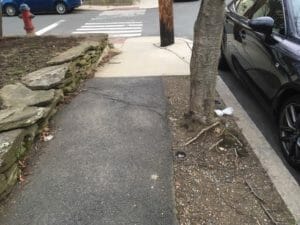Urban housing and accessibility
Look around any urban landscape and you will see multiple problems for people who use wheelchairs, walkers, canes, or other aids for walking.
Getting into the house
 Think about the typical Somerville, Cambridge, Arlington, Watertown, or Boston house. Almost all of them have several steps up to the front door. Many have limited land. Therefore, how would somebody who can’t walk upstairs get home? Most rely on lifts instead of ramps because of space limits.
Think about the typical Somerville, Cambridge, Arlington, Watertown, or Boston house. Almost all of them have several steps up to the front door. Many have limited land. Therefore, how would somebody who can’t walk upstairs get home? Most rely on lifts instead of ramps because of space limits.
To build a ramp that is not too steep for a wheelchair user, the ramp needs to be about 1 foot long for every inch of vertical lift. Steps that are 2 feet high don’t seem like much for a house around here, right? But that would require 24 feet of ramp.
Once inside…
Inside of houses, people who use wheelchairs need doorways that are 36 inches wide. Look around your house and measure yours. Chances are your doorways are around 30 inches.
In order to turn a wheelchair, there needs to be a 4 foot circle of empty floor space. How many of those do you have in your house?

For these reasons, many people who use wheelchairs have limited options if they want to live in urban environments that have older housing stock, like here around Boston. Many compromise and live in apartment buildings where there are elevators. Newer buildings with many apartments or condos will have lobbies that are stair-free. But what about people who use wheelchairs who also want to live in houses so they can enjoy yards, privacy, and the same things everybody else enjoys, living in houses?
And what about outside?


Even when someone uses a wheelchair, walker, cane, or other aid for walking can find a house in an urban area that meets their needs, they still have to contend with the conflict between street with trees and streets they can travel on. Trees and utility poles get in the way of people who use walkers, canes, or wheelchairs.
When we consider affordable housing for elderly people, we need to consider that many will be temporarily or chronically using wheelchairs, canes, walkers and other walking aids. For a community to support elders living in their midst, that community needs to look at both its housing and its streets.